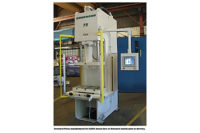When K.A. Swanstrom founded Penn Engineering & Manufacturing Corp. in 1942, he did so with a revolutionary new product: a self-clinching fastener that provides load-carrying threads in metal sheets too thin to be tapped.
At first, Swanstrom produced the fastener with four machines in a Doylestown, PA, garage. However, this simple operation soon gave way to a modern facility in Danboro, PA, because manufacturers and engineers alike recognized the fastener’s load-carrying benefit.
Multi-industry acceptance of the fastener led to its high-volume production shortly after World War II. Over time, the original fastener design was modified to meet new applications involving ultra-thin and ultra-light metals.
The company also expanded its product line to include many types of PEM fasteners, the StickScrew screw-installation system and Pemserter fastener-insert presses. Today, PennEngineering serves manufacturers in several diverse industries.
PennEnginering has made several series of Pemserter presses since 1967. The initial press was powered by an air-over-oil system. But over time, Penn-
Engineering converted the press to an electronic system controlled by a Uni-drive SP drive from Emerson Industrial Automation. The SP series was chosen because it lowered cycle times and offered more changeover and feeder
options for greater flexibility.
This year, the company will introduce its latest Pemserter press, which allows machine operators to install fasteners while holding the work piece. PennEngineering’s engineers worked closely with Emerson and outside contractors to develop the press’s hardware and software.
Its key features are two Unidrive M700 servo drives and two servo motors that control one linear device. The drives enable and disable the motors on the fly to seamlessly transfer device control from one motor to the other. They also ensure the press ram delivers accurate force over the proper distance.
The servo drives feature onboard Ethernet, and they quickly integrate machine logic and motion control without the need for a PLC. More importantly, the drives make the press RoHs (Restriction of Hazardous Substances) II-compliant. This directive is a key requirement for electronics
manufacturing in Europe, which is one of PennEngineering’s primary markets.
For more information on servo drives and motors, call 314-553-2000 or visit www.emersonindustrial.com.








